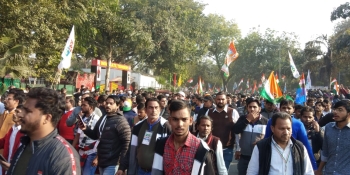
.jpg) Lancy Lobo
Lancy Lobo

The mainstream media has kept a brutal silence over the Bharat Jodo Yatra of Rahul Gandhi. However, the social media has been consistently reporting the movement, dynamics, and response of the people at different points of the Yatra.
I was inclined to participate when the Yatra reached Delhi. One could register for the yatra which I did. With few Jesuits we went to India Gate where it was passing by. Along the route there were posters of the yatra, Rahul Gandhi in different attires. The security personnel were like a line of ants drawn from different sources along the route. There were also some onlookers along the route who were eventually sucked into the Yatra. Initially there was a trickle at the head of Yatra. There were vehicles with flex posters, loudspeakers, music. The numerous drums and shouts rent the air. Elderly men, women, middle aged and the youth were running, walking, and trudging on the route. But, when the portion centring round Rahul Gandhi passed by it was a tsunami of people, walking speedily, brushing aside even the security personnel.
Our Jesuit group could not stick together in the march due to the sheer speed and force of the crowd and we got dispersed. The feeling of marching with the Yatris was unique and very moving. I thought of M.K. Gandhi’s marches during Freedom Movement. I felt as if I am participating in the second Freedom Movement, of freeing the country of divisive and fascist tendencies.
I looked back to other Yatras undertaken by politicians in the recent decades. The ones that came to my mind were those of Narendra Modi and L. K. Advani in the 1980s. The background for these Yatras was obviously the Hindu nationalist ideology which got a window of opportunity in the Meenakshipuram Conversion of 150 Dalit families to Islam in 1981 which roused RSS affiliates to project Hinduism in danger by changing the demographic character of India. For politically gainful unity of Hindus, Meenakshipuram event triggered off communal riots in many parts of the county. Huge (Virat Hindu Sammelans) gatherings and rallies of Hindus were organised to inflame passions. Dharma Sansad (Parliament of Hindu religion) came into being. Ekatmata Yatra was launched by BJP in 1983 where huge processions, marches or Yatras were organised. VHP claimed that more than 60 million people participated in these Yatras over 85,000 kms criss-crossing India. There were three main Yatras: 1) Kathmandu to Rameshwaram; 2) Haridwar to Kanyakumari; and 3) From Gangasagar in the east to Somnath in western Gujarat. Modi played a crucial role in organising the logistics of the Yatras in Gujarat.
Further Gujarat had annual Rath Yatras in Ahmedabad which passed through sensitive Muslim areas raising provocative slogans against them in 1985. BJP’s rise to power in Gujarat had much to do through these yatras. L.K. Advani having become the President of the BJP replacing A. B. Vajpayee gave up the concept of Gandhian socialism and brought religion firmly into Indian politics. Advani’s Rath Yatra from Somnath traversing several parts of India was once again successfully organised by none other than Modi. Not only Modi became Chief Minister for many terms in office, he also became the Prime Minister of India.
Religious Yatras in Gujarat are very popular particularly to regional female deities in the north Ambaji, in the west Chamunda, in the centre Pavagadh and there are also sectarian pilgrimages which are well organised. However, the Yatras though having a religious connotation have transforming impact on political landscape. People marching together quickly connect, establish rapport, share and care.
Bharat Jodo Yatra is using the religious idiom of pilgrimage to unite India across religions, regions, languages, castes, tribes, classes and sects. The focal point is that India has been divided across the above-mentioned primordial ties for political gain by a few by uniting under a majoritarian umbrella. This majoritarianism is detrimental to minorities as well as those among the majoritarian community. The secular fabric of India and democracy have been dismantled and the Constitution is in danger of being replaced.
Rahul appears to present a binary opposite picture of Modi during the Bharat Jodo Yatra. His dress, diet, and demeanour are simple, appealing to cross sections of people, drawing huge crowds. Modi too came to power enduring lots of hardships though he now enjoys a singular privilege in his dress, diet and demeanour. Any biography of Modi will show how his life has been when he was an RSS Pracharak: simple, ascetic, and very common.
The Bharat Jodo Yatra has rattled BJP leaders. Their troll army is busy spreading lies about Rahul and the Yatra. One question that is asked about this Yatra is ‘will it harvest votes?’ It appears that the sickle is laid to harvest but until the Congress builds a cadre at the local level like reviving Seva Dal of yore this Yatra may not harvest votes.
Coming to the streets in protest has proven in the past a very effective tool used by civil society organisations. The protest movements becoming mass movements have proven to be the sole means when all other avenues such as legal and dialogical have been tried. Dictators, autocrats, authoritarian leaders have been brought down through people coming on to the streets. Social transformation comes through protest movements, whether farmers, students, women, tribal, Dalit, industrial, or all put together.
Finally, one word about the Christian processions, marches and Yatras. Obviously, these are basically religious: well organised, disciplined and systematic. They do not even need police protection or security even though it is mandatory. While one may admire our processions, are we Christians not too tame and timid. Joining political marches and Yatras may inject some Jusso in our veins and bones. These Yatras have great educative value to instil confidence in ourselves.